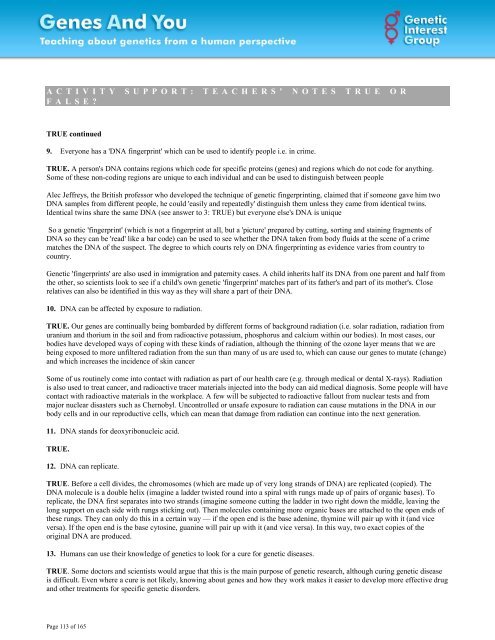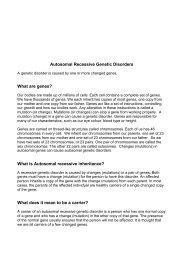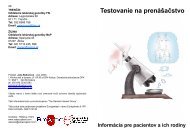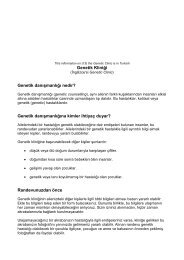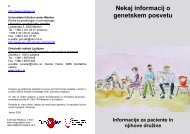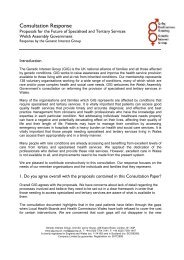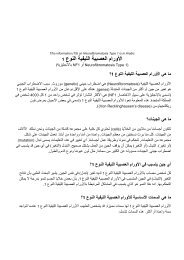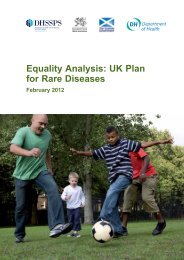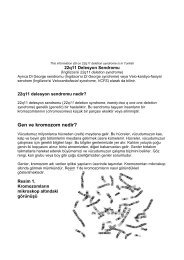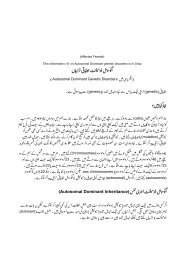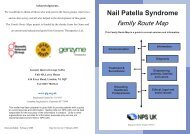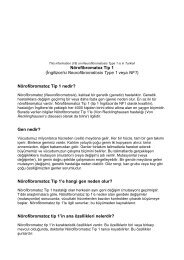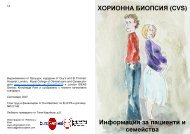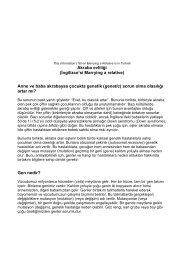TRUE OR FALSE? - Genetic Alliance UK
TRUE OR FALSE? - Genetic Alliance UK
TRUE OR FALSE? - Genetic Alliance UK
Create successful ePaper yourself
Turn your PDF publications into a flip-book with our unique Google optimized e-Paper software.
A C T I V I T Y S U P P O R T : T E A C H E R S ’ N O T E S T R U E O R<br />
F A L S E ?<br />
<strong>TRUE</strong> continued<br />
9. Everyone has a 'DNA fingerprint' which can be used to identify people i.e. in crime.<br />
<strong>TRUE</strong>. A person's DNA contains regions which code for specific proteins (genes) and regions which do not code for anything.<br />
Some of these non-coding regions are unique to each individual and can be used to distinguish between people<br />
Alec Jeffreys, the British professor who developed the technique of genetic fingerprinting, claimed that if someone gave him two<br />
DNA samples from different people, he could 'easily and repeatedly' distinguish them unless they came from identical twins.<br />
Identical twins share the same DNA (see answer to 3: <strong>TRUE</strong>) but everyone else's DNA is unique<br />
So a genetic 'fingerprint' (which is not a fingerprint at all, but a 'picture' prepared by cutting, sorting and staining fragments of<br />
DNA so they can be 'read' like a bar code) can be used to see whether the DNA taken from body fluids at the scene of a crime<br />
matches the DNA of the suspect. The degree to which courts rely on DNA fingerprinting as evidence varies from country to<br />
country.<br />
<strong>Genetic</strong> 'fingerprints' are also used in immigration and paternity cases. A child inherits half its DNA from one parent and half from<br />
the other, so scientists look to see if a child's own genetic 'fingerprint' matches part of its father's and part of its mother's. Close<br />
relatives can also be identified in this way as they will share a part of their DNA.<br />
10. DNA can be affected by exposure to radiation.<br />
<strong>TRUE</strong>. Our genes are continually being bombarded by different forms of background radiation (i.e. solar radiation, radiation from<br />
uranium and thorium in the soil and from radioactive potassium, phosphorus and calcium within our bodies). In most cases, our<br />
bodies have developed ways of coping with these kinds of radiation, although the thinning of the ozone layer means that we are<br />
being exposed to more unfiltered radiation from the sun than many of us are used to, which can cause our genes to mutate (change)<br />
and which increases the incidence of skin cancer<br />
Some of us routinely come into contact with radiation as part of our health care (e.g. through medical or dental X-rays). Radiation<br />
is also used to treat cancer, and radioactive tracer materials injected into the body can aid medical diagnosis. Some people will have<br />
contact with radioactive materials in the workplace. A few will be subjected to radioactive fallout from nuclear tests and from<br />
major nuclear disasters such as Chernobyl. Uncontrolled or unsafe exposure to radiation can cause mutations in the DNA in our<br />
body cells and in our reproductive cells, which can mean that damage from radiation can continue into the next generation.<br />
11. DNA stands for deoxyribonucleic acid.<br />
<strong>TRUE</strong>.<br />
12. DNA can replicate.<br />
<strong>TRUE</strong>. Before a cell divides, the chromosomes (which are made up of very long strands of DNA) are replicated (copied). The<br />
DNA molecule is a double helix (imagine a ladder twisted round into a spiral with rungs made up of pairs of organic bases). To<br />
replicate, the DNA first separates into two strands (imagine someone cutting the ladder in two right down the middle, leaving the<br />
long support on each side with rungs sticking out). Then molecules containing more organic bases are attached to the open ends of<br />
these rungs. They can only do this in a certain way — if the open end is the base adenine, thymine will pair up with it (and vice<br />
versa). If the open end is the base cytosine, guanine will pair up with it (and vice versa). In this way, two exact copies of the<br />
original DNA are produced.<br />
13. Humans can use their knowledge of genetics to look for a cure for genetic diseases.<br />
<strong>TRUE</strong>. Some doctors and scientists would argue that this is the main purpose of genetic research, although curing genetic disease<br />
is difficult. Even where a cure is not likely, knowing about genes and how they work makes it easier to develop more effective drug<br />
and other treatments for specific genetic disorders.<br />
Page 113 of 165


